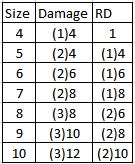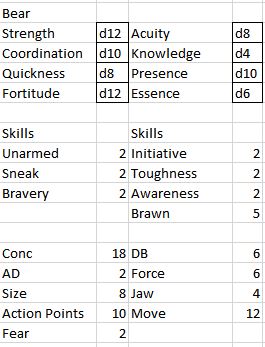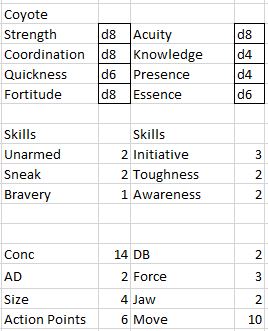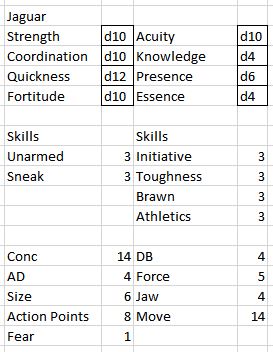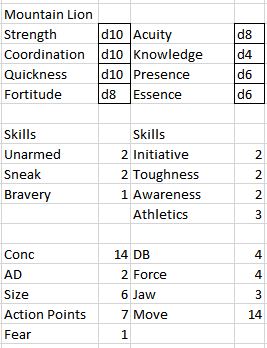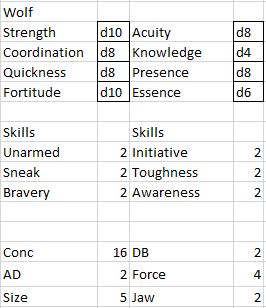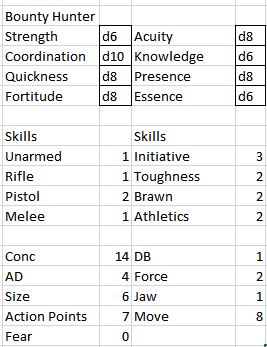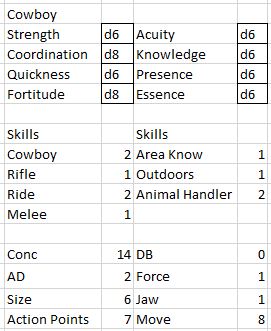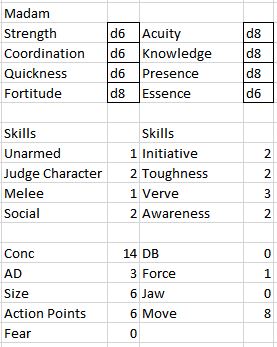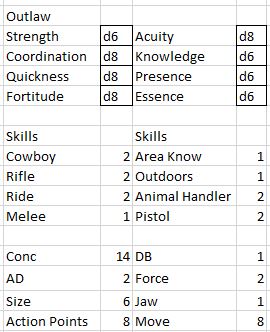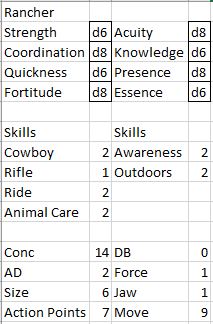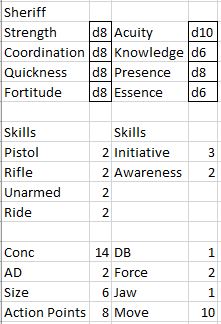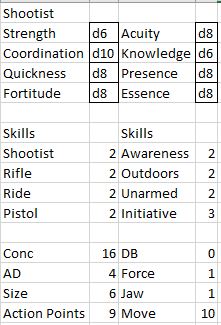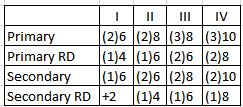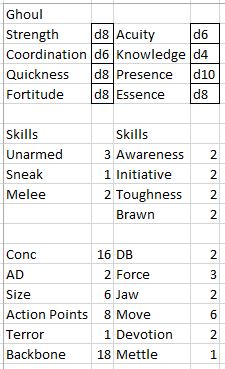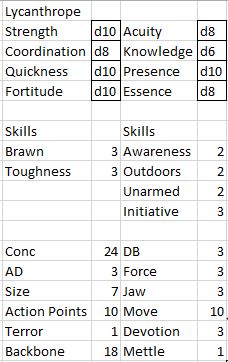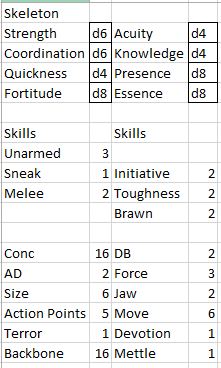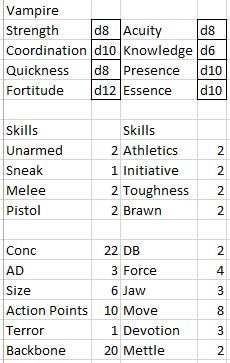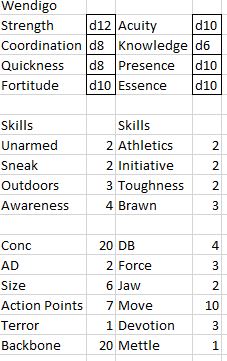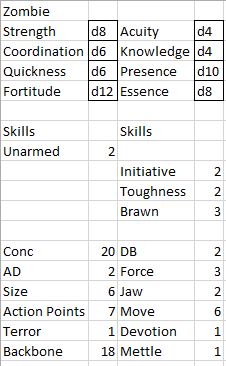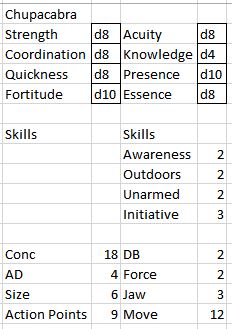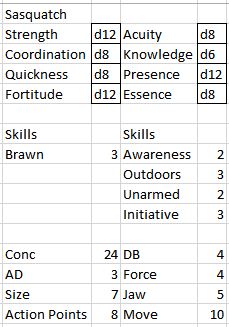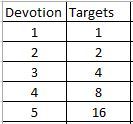Difference between revisions of "The West That Wasnt - Adversaries"
(→Masterminds in Supernatural Stories) |
|||
| (16 intermediate revisions by one other user not shown) | |||
| Line 1: | Line 1: | ||
[[The West That Wasnt - Rulebook|Back to Main Page]] | [[The West That Wasnt - Rulebook|Back to Main Page]] | ||
| − | The West is home to all manner of | + | The West is home to all manner of varmints. Critters, too, as well as men and women from all walks of life. This bestiary contains Traits and Skills for a wide range of them, both mundane and supernatural (should your game head that direction). Rather than a roster of enemies and their traits, this bestiary provides all the building blocks a Judge should need to create unique adversaries for their story. Each entry lists a set of traits followed by important skills or attributes. If a Trait Skill is not listed, it is assumed to be 1. If a Regular Skill is not listed, it is not possessed. |
| − | + | If the entry is an Animal, a few things should be noted. First, Animal bites are deadly attacks. Claws, however, are typically impact attacks (subject to the Judge’s discretion; long or particularly sharp claws are typically deadly.) Most animals begin a fight with claw attacks. Bite attacks are at -2 unless it is the animal’s primary attack. Creatures of Size 8 or greater cause Fear when within a single move (a number of paces equal to their Move value). Finally, animals deal combat damage based on their size and the following table: | |
| − | + | ||
| − | + | ||
[[image:animalattacks.JPG]] | [[image:animalattacks.JPG]] | ||
| − | |||
| − | |||
=The Mundane= | =The Mundane= | ||
| − | + | Even without the Supernatural, the West is full of threats both big and small. Some common examples are listed here for reference, from hard characters to wild animals. | |
==Animals of the West== | ==Animals of the West== | ||
[[image:bear.JPG]] | [[image:bear.JPG]] | ||
| − | + | There are three main species of bear in North America, and each of them is deadlier than the last. From the smallest Brown Bear to the wildest Grizzly, each specimen is at least 400 pounds of solid muscle armed with a full complement of fangs and claws. Stats provided describe a typical specimen, but larger and more powerful examples certainly exist. Bears have claw and bite attacks. The size of a typical bear ranges from 8 to 9, with more massive specimens reported at size 10. | |
[[image:boar.JPG]] | [[image:boar.JPG]] | ||
| − | Wild boars are | + | Wild boars are a common sight throughout the West. Though it’s rare for one to attack a human, when they do, the resulting fight is often vicious and bloody. Insatiable and omnivorous, the wild boar uses its 6-inch tusks as Deadly Attacks. |
[[image:coyote.JPG]] | [[image:coyote.JPG]] | ||
| − | Coyotes are small predators | + | Coyotes are small, savvy predators that feature as tricksters in many Native American legends. Though about the size of a scrawny dog, even a single coyote can spell trouble if its prey is caught unawares. Because coyotes are pack hunters they are most often encountered in pairs or small groups. Coyotes have bite attacks. |
[[image:jaguar.JPG]] | [[image:jaguar.JPG]] | ||
| − | Jaguars are the largest | + | Jaguars are the largest felines in the New World. Often weighing in at over 300 pounds, they silently stalk their prey until the perfect moment presents itself. Then, they strike. Though Jaguars are ambush predators, they are capable of great bursts of strength and speed. Thankfully, Jaguars prefer to avoid contact with humans, and will only attack when cornered. Jaguars have both claw and bite attacks. |
[[image:mountainlion.JPG]] | [[image:mountainlion.JPG]] | ||
| − | Mountain | + | Mountain Lions (also known as cougars) are large, tawny predators that stalk the West, waiting to ambush their prey. These solitary hunters are nocturnal, and are rarely seen during the daylight hours. They frequently avoid humans and larger animals, preferring stealth to confrontation. Mountain Lions have claw and bite attacks. |
[[image:wolf.JPG]] | [[image:wolf.JPG]] | ||
| − | + | It’s easy to forget how big a wolf is. Nearly three feet tall at the shoulder, these pack hunters have a well-earned reputation as the alpha predator in the American West. Smart, social, and armed with powerful jaws, Wolves have been the end of many an unsuspecting traveler lost in the wilderness. Wolves have bite attacks. | |
==Citizens of the West== | ==Citizens of the West== | ||
| − | Every city, town, farmstead and ranch | + | From Doc Holliday to the Unsinkable Molly Brown, the Wild West isn’t anything without the people who inhabit it. Every city, town, farmstead and ranch has its own cast of characters, who might serve as stalwart allies or devious adversaries for any given posse. The following entries serve as an excellent starting point for a Judge looking to populate their particular corner of the West. |
[[image:bouncer.JPG]] | [[image:bouncer.JPG]] | ||
| − | + | There’s a line drawn at the door of every saloon, bar, and road-house. It’s the doorman’s job to keep the riff-raff on the right side of that line. Of course, some are better at keeping the rowdiest violence outside than others-- and some are responsible for the worst of it. If a posse wants to raise trouble in these establishments, chances are they’ll have to deal with the doorman. | |
[[image:bountyhunter.JPG]] | [[image:bountyhunter.JPG]] | ||
| − | + | Law in the Wild West is patchwork, at best. Sometimes, all a miscreant needs to do to escape the law is to run to the next town. That’s where Bounty Hunters come in. Bounty hunters track their quarry through civilization and wilderness alike. Some are paragons of justice, working with US Marshals to track down outlaws and fugitives. Others are hard-bitten killers, doing whatever work someone’s willing to pay for. All of them are capable, deadly individuals. Those that aren’t, don’t last long. | |
[[image:cowboy.JPG]] | [[image:cowboy.JPG]] | ||
| − | Cowboys are | + | Cowboys are a common sight in the West. Strictly speaking, it’s a rough, dirty, under-paid job, but it’s one that anyone who knows their way around livestock can get. Many a man, woman, and child has found steady work as a Cowboy, tending to cattle on the long drives from pasture to market, through the vast expanses of the American West. |
[[image:madam.JPG]] | [[image:madam.JPG]] | ||
| − | + | It takes steel to be a Madam in the Wild West. Some are entrepreneurs, some are criminal kingpins, but each of them is a dangerous figure in their own right. Sooner or later, if a posse finds themselves in an establishment of a particular reputation, they’ll encounter a Madam. | |
[[image:outlaw.JPG]] | [[image:outlaw.JPG]] | ||
| − | + | An Outlaw is anyone who finds themselves on the other side of society, sometimes by circumstance, but often by choice. All too often, the allure of the lawless West draws capable individuals to a life of greed and violence. Of course, one man’s outlaw is another’s hero. | |
[[image:rancher.JPG]] | [[image:rancher.JPG]] | ||
| − | + | The wide open ranges of the West are ideal for raising livestock. Many settlers make their living tending cattle, raising herds that number in the hundreds. These Ranchers make up the backbone of the West’s economy, often employing everyone from cowboys to shootists. | |
[[image:sheriff.JPG]] | [[image:sheriff.JPG]] | ||
| − | + | With small towns cut off from one another by days of travel through the wilderness, the Sheriff is often the only source of law and order in the West. As an elected position, a Sheriff is the final word on law enforcement in many small communities, and can deputize unaffiliated individuals to tackle problems plaguing the townsfolk as necessary. | |
[[image:shootist.JPG]] | [[image:shootist.JPG]] | ||
| − | + | A ‘Shootist’ is the term for a hired gun. Many in the West need the skills and services of a professional shootist at one point or another, some for protection or security, and others for more nefarious ends. | |
=The Supernatural= | =The Supernatural= | ||
| − | + | The Wild West is full of legends. From the Wendigo to La Llorona, many of these legends are inextricably tied to the lands and the stories they came from. With that in mind, the following profiles are not meant to be exhaustive. Rather, they’ve been provided to let you, as a Judge, combine them with the ‘Attacks’ table to build supernatural enemies of your own. | |
| − | Supernatural | + | Supernatural adversaries can (and often do) use many different types of attacks. Physical attacks are listed on the following table: |
[[image:supernaturalattacks.JPG]] | [[image:supernaturalattacks.JPG]] | ||
| − | + | Each profile features a primary attack, which is the preferred method for the given adversary. Some entities may have one or more secondary attacks, which are likewise listed in the profile. As with animals, bite attacks are made at -2 to hit (unless otherwise specified). | |
==Using Supernatural Enemies== | ==Using Supernatural Enemies== | ||
| − | + | The following profiles include everything that the Judge needs to incorporate these supernatural entities into their game, from descriptions and abilities to sample adventure hooks. The entries provided are designed to be adapted to individual sagas, of course, which means that the monsters as provided may not be the ones that appear in your game. The Judge has the final say on exactly what a supernatural entity can do. | |
==Humanoid Supernatural Entities== | ==Humanoid Supernatural Entities== | ||
| − | + | Many supernatural adversaries were once human. Or perhaps, they were never human, but simply appear that way. Regardless, the category of Humanoid Supernatural Entities covers a wide range of creatures, from the undead to the never-quite-alive. | |
===Ghoul=== | ===Ghoul=== | ||
[[image:ghoul.JPG]] | [[image:ghoul.JPG]] | ||
| − | + | Originally from Arabic folklore, the Ghoul is an undead abomination that haunts graveyards and charnel grounds all throughout the West. Their association with corpses and decay is well earned, as they have been known to survive on the flesh of the living or recently deceased. It is speculated that they gain nourishment from the souls of the departed, according to their preference for both those recently passed, and for victims they have killed themselves. | |
| − | + | “Fresh” ghouls can pass for humans, for a time. As they age, however, they quickly devolve: their skin turns corpse-grey, their hair becomes thin and patchy, and many develop sores and blemishes as they succumb to their diet and lifestyle. | |
Ghoul claws (Primary, Class I) and bites (Class I) are deadly. Ghouls can also use standard humanoid hand-to-hand attacks and defenses. | Ghoul claws (Primary, Class I) and bites (Class I) are deadly. Ghouls can also use standard humanoid hand-to-hand attacks and defenses. | ||
====Ghoul Adventure Seeds==== | ====Ghoul Adventure Seeds==== | ||
| − | First it was livestock, | + | First, it was livestock. Mutilated bodies found in their pastures, with guts and viscera spilled across the snow. It seemed as though they had been partially eaten, but not by any animal known to the locals. Then, some of the locals began to disappear. |
| + | |||
| + | Old Man Lannigan was questioned, as it had been noted that he was acting strange ever since returning from a trip to his jealously guarded gold vein. Locals pass him over as a harmless old codger, until a young boy disappears just downstream from his cottage... | ||
| + | |||
| + | ===Lycanthrope=== | ||
| + | [[image:lycanthrope.JPG]] | ||
| + | |||
| + | Folklore across the globe features stories of regular people hiding a monster within. We’re all familiar with the story: most of the time, these figures appear as normal individuals. But during the full moon, the true scope of their depravity is revealed. | ||
| + | |||
| + | “Lycanthrope” is a catch-all term for these beasts, whether they are a werewolf, a werebear, or some other hybrid creature entirely. Were-creatures are vicious and strong, with all of the raw savagery of their inner beast, combined with the natural cunning and intellect of a human. Though most transformations are connected to the full moon, all manner of transformation conditions are said to exist. | ||
| + | |||
| + | Lycanthrope claws (class II, Primary) and bites (class II, Secondary) are deadly. In addition, if a lycanthrope’s victim survives the attack, their bites are commonly believed to spread the condition. | ||
| + | |||
| + | ====Lycanthrope Adventure Seeds==== | ||
| + | It happened again. | ||
| + | |||
| + | These bodies, just like the last ones, were discovered the morning after the full moon. Mr. and Mrs. Jameson, in their isolated ranch-house, were torn to shreds in what one local described as “a devilishly thorough manner.” No tracks were found, and no signs of forced entry were apparent. With less than a month until the next full moon, the community is on the verge of tearing itself apart. Will whoever performed these reprehensible acts be discovered? Or will the small town dissolve into chaos and suspicion? | ||
===Skeleton=== | ===Skeleton=== | ||
[[image:skeleton.JPG]] | [[image:skeleton.JPG]] | ||
| − | + | The Wild West is a place to hide-- sometimes from the law, sometimes from parties you’ve wronged, and sometimes from pitchfork-bearing mobs intent on ending your… experiments. Sinister legends speak of mysterious figures with some over the forces of life and death, and of bodies of the deceased that once again walk among the living, returned as mindless servants on some unknowable task. | |
| − | Skeleton claws (Primary, Class I) are deadly. Skeletons have no secondary attack. | + | Animated skeletons are mindless automatons that must be controlled by another being. Because of their nature, skeletons are difficult to damage with most firearms. As such, they have an AV of 3 vs. any firearms (with the exception of shotguns, against which they have an AV of 1.) Any damage that does not cause a wound is ignored. Skeleton claws (Primary, Class I) are deadly. Skeletons have no secondary attack. |
====Skeleton Adventure Seeds==== | ====Skeleton Adventure Seeds==== | ||
| − | + | There’s a lot of bad blood between the Double X and the Bar T. What started as a simple spat over a wrongly placed fencepost has festered into a long-standing feud. When the conflict ended in bloodshed at the local saloon, Sheriff Reilly did what he could to end the fighting, visiting both ranches regularly over the last month. Both ranchers say they’ll stop when the other does. | |
| + | |||
| + | Recently, despite a tenuous ceasefire, cowpokes from Bar T were discovered slashed to ribbons out on the range. Most of them were face-down, with grisly wounds up and down their backs. No-one knows what caused such hardened men to run, but whispers tell of old graves on Boot Hill, dug up and emptied. Some of them, seemingly, from the inside. | ||
===Vampire=== | ===Vampire=== | ||
[[image:vampire.JPG]] | [[image:vampire.JPG]] | ||
| − | + | A Vampire is a human-shaped supernatural creature that survives by consuming the life-force of living beings. Beyond that simple delineation, a dizzying variety of traits can be pinned to this category of monster. Some vampires drink blood and cringe away from religious symbols. Some vampires emerge during the daylight and can turn into roaches. There are even whispers, among the Chinese railroad workers, of vampires who can only hop towards their victims, to feed on their spinal fluid. | |
| − | + | The appearance and hunting tactics of a given vampire can vary greatly from specimen to specimen. If a vampire looks (for all intents and purposes) to be a human, they must spend an action (4 AP) to cause Terror. All vampires have 2 AV vs. Deadly Attacks, and vampire bites are Deadly. | |
| − | + | Vampires come in a frightening array of horrific manifestations, but the stats provided here are for the more mundane variety. As such, they may have a full character sheet, background, and place in society. Vampires such as these provide an excellent nemesis for your posse. | |
| − | + | Though they are capable of standard hand-to-hand attacks, vampires can also use their claws (Secondary, Class I) and bites (Primary, Class II), as well as any supernatural abilities they may have. A preferred attack is to immobilize their prey with their claws before attempting to bite. | |
====Vampire Adventure Seeds==== | ====Vampire Adventure Seeds==== | ||
| − | + | Molly Burch vanished. Her last known location, according to the bounty hunter hired by her father to track her down, was the town of McKinley Bluff. | |
| + | |||
| + | According to the last letter the bounty hunter sent, McKinley Bluff is a quiet hamlet, miles away from the nearest settlement. He planned to make the trip three weeks ago. Molly’s father hasn’t heard from him since, and now a desperate Mr. Burch is looking to hire a posse to follow up on the lead. Rumors about McKinley Bluff swirl thick, about the enigmatic mayor, and the devotion the townsfolk show him. Time to saddle up and ask some questions. | ||
===Wendigo=== | ===Wendigo=== | ||
[[image:wendigo.JPG]] | [[image:wendigo.JPG]] | ||
| − | + | Stories of the Wendigo can be found all across the North American continent. Many nations pass along the legends, from the Algonquins of the North East, to the Ojibwe, to the Cree. All of the stories, no matter where they’re told, are about the same things: madness, cannibalism, and the cold, dark winter. | |
| − | + | Often described as a tall, gaunt, human-shaped spirit, the Wendigo is blamed whenever a snow-bound traveller resorts to eating their companions. Some say the Wendigo possesses these unfortunate souls, driving them to acts of gluttonous cannibalism. Some say the Wendigo is what is left after someone crosses that taboo, growing taller, thinner, and ever more hungry as they wander the cold, black forest in search of prey. | |
| − | Though the Wendigo | + | Though the Wendigo originates in the ice-bound Northern forests, stories of gruesome cannibalism have spread throughout the West. It’s unclear whether the Wendigo is responsible, but all the tell-tale signs are there. Just ask the Donner Party. |
====Wendigo Adventure Seeds==== | ====Wendigo Adventure Seeds==== | ||
| − | Jock Curtis was | + | No-one thought much of Jock Curtis. When he didn’t show up at the Winter rendezvous after insisting on taking his “short-cut,” the most anyone could muster was a shrug and an “I told you so.” And, when the remains of his horse and wagon were found the next Spring, everyone figured Jock had wandered off and gotten himself killed in a tree-well. |
| + | |||
| + | No-one knew, however, that Jock came from old money back East. Word came on a wagon train that his sister was looking for proof of his demise, on account of a poorly-worded will and, potentially, a great deal of money. She’s willing to pay handsomely. Of course, rumors of a strange figure lurking near the tree-line are no problem for a professional posse... | ||
===Zombie=== | ===Zombie=== | ||
[[image:zombie.JPG]] | [[image:zombie.JPG]] | ||
| − | Zombies are the | + | Zombies are the mindless, shambling corpses of the recently deceased. Variations exist, of course, with rumors of poisonous powders wielded by nefarious practitioners of dark magic matched by stories of terrifying, rabies-like plagues. Regardless of origin, Zombies are simple, hunger-driven creatures. Some are capable of following rudimentary directions, and others are mindless, ravenous monsters, intent only on spreading whatever sickness animates them. |
| − | + | Zombie bites (Class I) are deadly. They are also capable of punch (Quick Attack) and hold (Standard) attacks. If a Zombie manages to achieve partial or full dominance with a Hold Attack, their next attack will be a bite. | |
| − | + | ||
| − | Zombie bites (Class I) are deadly. | + | |
====Zombie Adventure Seeds==== | ====Zombie Adventure Seeds==== | ||
| − | + | The Davidson homestead is quiet. After their youngest daughter came down with a nasty flu, Doc Anderson travelled out to the isolated compound to check up on her, and make sure the rest of the extensive family was doing all right. | |
| + | |||
| + | That was ten days ago. Doc Anderson hasn’t returned, nor has any word from the Davidson family come back to the nearby town. The only information available came to Powell’s Saloon by way of a lone traveller, who told a drunken story about strange, silent figures at the homestead, and livestock, left to rot in their fields, half-eaten. Someone has to find out what happened out there. If not for the Davidsons, then for the community at large. | ||
==Monstrous Supernatural Entities== | ==Monstrous Supernatural Entities== | ||
| Line 154: | Line 172: | ||
[[image:chupacabra.JPG]] | [[image:chupacabra.JPG]] | ||
| − | The | + | The Chupacabra is a fixture of folklore in the Southwest and Mexico; a legendary creature rumored to drain the blood from its victims. It gets its name (Chupacabra literally means “goat-sucker”) from its preferred prey, though it has been known to target anything it can get its claws on. |
| − | + | Chupacabras range in size from Sz. 5 to 7, though larger specimens have been rumored to exist along the Border. They prefer to hunt by stealth, savaging their victims before they have a chance to react. Bodies of victims are found, pale and drained, with ragged holes chewed in their pelts. They don’t normally target humans specifically, but they very well might, if provoked. | |
| + | |||
| + | Chupacabras have Claw attacks (Class I) and Bite attacks (Class II). They also possess a spiny mane, which causes Class I damage on any individual unlucky enough to try to wrangle the creature. | ||
| + | |||
| + | |||
| + | ====Chupacabra Adventure Seeds==== | ||
| + | At first, the livestock died standing in their pasture. Cattle would be found, still upright, drained of every last drop of blood. The owner of the Bar L has lost a small fortune already (not to mention the expense of trying to dispose of the bodies.) | ||
| + | |||
| + | Then, the livestock began to disappear entirely. Dragged, it seems, towards the arroyo on the south end of the property. A local tracker reports hearing a cacophony of sounds among the blasted sand-stone cliffs; one deep cry and a half-dozen smaller ones. If he didn’t know any better, he says, he’d guess they were breeding. | ||
===Sasquatch=== | ===Sasquatch=== | ||
[[image:sasquatch.JPG]] | [[image:sasquatch.JPG]] | ||
| − | + | “Sasquatch” is the name given to a wide collection of sightings, stories, and reports of a massive forest-dwelling humanoid in forests throughout the West. Vanishingly rare, they are frequently only encountered by lone trappers and wilderness scouts, on the farthest fringes of civilization. What reports are given, however, are surprisingly similar: an ape-like being, broad-shouldered and massively strong, typically upwards of seven feet tall. Stories vary on the behavior of the Sasquatch, with some legends telling of a benevolent and mysterious figure, and others warning of a cruel and vicious killer. | |
| + | |||
| + | The Sasquatch can Punch (Class II) and Bite (Class II). If provoked to fight, a Sasquatch will try to pummel its victims into submission before gnawing and potentially consuming them. | ||
| + | |||
| + | ====Sasquatch Adventure Seeds==== | ||
| + | When Old Thom came back from the other side of the Sangre River, he was half-mad with fear and hunger. He’d been stranded, he said, cut off from the rest of his party in the wilderness and had given up hope of ever finding his way back, when he encountered a massive, white-haired creature, as tall as a bear. The creature, he said, rescued him, and delivered him safely to the edge of civilization. | ||
| − | + | Rumors of this creature have spread far and wide since Old Thom came back, and now the small town is full to the gills with big game hunters and ne’er-do-wells looking to make a name for themselves. Old Thom is looking for help to ward off the hunters, but of course, the pelt alone would net some lucky individual a veritable fortune... | |
==Spirits and Hauntings== | ==Spirits and Hauntings== | ||
| Line 182: | Line 213: | ||
Constructs are created from multiple dead bodies to form a single, new whole. The Frankenstein monster is an example of a construct. Constructs are physically powerful, but mentally weak, and require direction from an outside source. | Constructs are created from multiple dead bodies to form a single, new whole. The Frankenstein monster is an example of a construct. Constructs are physically powerful, but mentally weak, and require direction from an outside source. | ||
| + | |||
| + | ==Cults and Cabals== | ||
| + | When mundane individuals unite in service of a supernatural entity or belief system, the cult created can be a flexible and challenging set of adversaries. Cults are by their very nature secretive, and their ability to remain faceless is key to their strength. | ||
| + | |||
| + | Cult members, and especially their leaders, are often upstanding citizens who wield considerable power be it supernatural or political. Their plans often involve laying the blame on the innocent and powerless. Cults offer the opportunity to have a mix of enemy types, from gun hands to mystics, with power over the physical as well as the supernatural. Dealing with a well organized cult can offer escalating and diverse challenges throughout a campaign arc. | ||
| + | |||
| + | Alternatively, a cult may be composed of the marginalized members of society, such as a disenfranchised indigenous tribe or a collection of Chinese railroad workers. In this case, secrecy is even more important since they are not able to wield any power in the mundane world to deflect blame when suspicion rears its head. The legends of those cultures offer rich troves of inspiration for supernatural entities a cult could serve. | ||
| + | |||
| + | ===Creating and Using Cults=== | ||
| + | Creating a cult requires three aspects: hierarchy, ideology and, most importantly, goals. The ideology should support the goals. In other words, if a cult is focused on opening a portal to a horrific outer dimension near a dormant silver mine, the ideology should be focused on that dimension. Something that dwells there is key to the belief, and that something has a reason to open that portal. And, of course, if that portal is opened the consequences will be terrible. | ||
| + | |||
| + | Hierarchy is more fluid. Some cults are nothing but a barely organized mob following the whims of a crazed seer. Others have multiple layers, with membership filling disparate roles and responsibilities. The organization itself is unimportant outside of how it interacts with the story that is being told. Cults tend to take on a personality, be it of the leader or the organization. | ||
| + | |||
| + | When using a cult as a story adversary, be sure to consider why any action is performed. Every act should forward the goals in some way, no matter how small or large. | ||
| + | |||
| + | Cults are also devious and ruthless, and will sacrifice members for the good of the organization, even when those members have strong relations to other members. Parents sacrifice children, brothers turn in sisters for crimes they did not commit, all to forward the aims of the cult. Use these sorts of surprises for shock and tragic value, and also to provide secondary goals and motivation for the Posse. | ||
==Masterminds in Supernatural Stories== | ==Masterminds in Supernatural Stories== | ||
| Line 192: | Line 239: | ||
A villain such as that is both monstrous and pitiable. Moreover, is it madness, or true insight driving her? Maybe the wolf was never dead and she is little more than a deranged killer. No matter what the solution, a mastermind such as this is memorable and engaging. | A villain such as that is both monstrous and pitiable. Moreover, is it madness, or true insight driving her? Maybe the wolf was never dead and she is little more than a deranged killer. No matter what the solution, a mastermind such as this is memorable and engaging. | ||
| − | =Creating Supernatural Abilities= | + | =Creating and Using Supernatural Abilities= |
Supernatural entities are most interesting when unique to your story. To that end, the abilities that entities possess should be crafted to the story as well. Most supernatural abilities should be governed by the Essence trait. There are three skills that can be used to help simulate the effects needed: Devotion, Mastery and Power. | Supernatural entities are most interesting when unique to your story. To that end, the abilities that entities possess should be crafted to the story as well. Most supernatural abilities should be governed by the Essence trait. There are three skills that can be used to help simulate the effects needed: Devotion, Mastery and Power. | ||
| − | Devotion is conviction in the face of adversity. It can be used by holy men and women to combat the supernatural, and also by supernatural entities to resist those efforts. For a supernatural entity, Devotion is the strength of their very existence. | + | Opening these skills to the Posse can change the tone of the campaign greatly. When the players can cow or otherwise shun the supernatural the enemies become much less challenging. |
| + | |||
| + | ==Devotion== | ||
| + | Devotion is conviction in the face of adversity. It can be used by holy men and women to combat the supernatural, and also by supernatural entities to resist those efforts. For a supernatural entity, Devotion is the strength of their very existence. | ||
| + | |||
| + | ===Using Devotion=== | ||
| + | Devotion can be used "offensively" to banish or otherwise cow certain supernatural entities. Whether or not an entity is subject to this effect is up to the Judge, and depends on the origin of the entity itself. Characters with a Devotion of at least 1 and the Religious Conviction Perk may attempt to affect a number of entities according to the following table: | ||
| + | |||
| + | [[image:cowentities.JPG]] | ||
| + | |||
| + | Using this ability costs 4 AP, and the character is considered prone for targeting purposes. The character must have an appropriate religious symbol or totem to make the attempt. During the turn the character focuses their religious conviction toward the creature(s). The TN is 4+(target's Devotion). Success causes the creature to stop what it is doing and retreat for as long as the character maintains the action. All attacks versus the retreating creatures are at +1. A bump causes the creature to instead freeze in place, being treated as prone for targeting purposes. Second and subsequent bumps also cause fear damage to the creature. Treat the character's Devotion level as their Fear level, and resolve an attack versus the creature's Backbone. A creature reduced to 0 Backbone in this manner is banished (it ceases to exist). | ||
| + | |||
| + | To maintain a banishment attempt a character must pay 4 AP each round, and continues to be considered prone for targeting purposes. The TN to maintain the attempt is 5. If the character was the target of any attacks since the initial action, they must first test Bravery to see if the attempt is broken. The character is subject to the rules presented in Chapter 4 - Combat Actions - Tactical Aiming. If their Bravery is at least 1 they may substitute their Devotion for Bravery when testing to see if the attempt is maintained. | ||
| + | |||
| + | ==Mastery== | ||
| + | Mastery is the ability of an entity to control other entities. Normally, the controlled beings are automatons, but entities with very high Mastery can control willful characters (non-automaton NPCs) as well. The TN to control automatons is based on the Devotion of the automatons and the number of them. The base TN is 3 plus the half Devotion level, rounded up, +1 additional per doubling of their number. For example, if a vampire wanted to control 5 Devotion 1 skeletons, the TN would be 6 (3 +1 for Devotion, +2 for 4-7 entities). Mastery checks are made when new directives are to be substituted for previous ones. When unsuccessful, the automatons continue doing what they were previously. On a critical failure, a new directive is implanted that is opposite (or significantly removed from) what was intended. | ||
| + | |||
| + | Controlling willful characters is significantly more difficult. The TN to control a willful NPC is 3 plus the rank of their Spirit trait, plus any Devotion levels they have. Thus to control a priest with Spirit 3 and Devotion 3 would be TN 9. | ||
| + | |||
| + | Controlling a Hero is a game unto itself, with difficulty determined by the player's choices. The base TN to control a Hero is 5 + (Spirit or Devotion rank). Determining the action is a three step process: | ||
| + | |||
| + | 1. Judge narrates what the being attempting the control wishes the Hero to do.<br> | ||
| + | 2. Player narrates what they wish to do instead.<br> | ||
| + | 3. Card is drawn to determine which occurs. On a success, the intended action occurs, on a failure, the player's response occurs instead. | ||
| + | |||
| + | The difficulty of the check is adjusted based on the difference between the actions narrated by the two sides. The closer the action chosen by the player is to the intent of the villain, the greater the increase in the TN. In other words, when a player attempts to do something close to the intent of the enemy, it is more likely that the player will be successful. When the player's action is diametrically opposed to the intent, the TN is unchanged, or even lowered by 1 or 2. When the action preserves some of the intent, add 1-2 to the TN. When it preserves virtually all of it, add 3-4. | ||
| + | |||
| + | For example, Cyril, Miranda and Hank are traveling with a deputy when they come upon a solitary rider, who turns out to be a vampire. At an opportune moment (for him), the vampire commands Cyril to turn and shoot Miranda. If Cyril declares: | ||
| + | |||
| + | I will shoot the vampire instead - TN-1<br> | ||
| + | I will draw my weapon and point it at Miranda, but not shoot - TN-0<br> | ||
| + | I will fire at Miranda, but deliberately miss - TN+1<br> | ||
| + | I will fire at the deputy instead - TN+2<br> | ||
| + | I will fire at Miranda's mount - TN+3<br> | ||
| + | |||
| + | The goal of the system is to give the player some narrative control over how the story unfolds, even when an adversary is able to take control of a character. By incentivizing choosing something closer to the intent of the acting entity, players are able to maintain some control while still choosing to do something that they would not normally choose. In effect, the player and Judge agree on how the enemy can influence the character. | ||
| + | |||
| + | ==Power== | ||
| + | Power is the ability of a supernatural entity to utilize a supernatural power. The skill is unique for each power. For example, a vampire might have the ability to transform into a bat, wolf or mist. This would be a single power (Shapeshifting), with different TN for each form (e.g. TN 5 for wolf, 7 for bat, 9 for mist). Another example could be the werewolf, and it's ability to howl at the moon and draw wolves to their aid. Powers need not be traditional; the possibilities are nearly endless. | ||
| + | |||
| + | Generally, the more suspension of disbelief, the higher the TN. In the vampiric transformation example above, the wolf form is the easiest because it is the closest to the human form in size and shape, whereas changing into a mist requires becoming nearly intangible so it is the hardest. An "average" use of a power has a TN of 5, with more difficult abilities being 7, 9 or more. Not all powers have multiple incarnations. | ||
| + | |||
| + | ==Sample Characters== | ||
| + | The following characters are examples of potential Posse members which utilize the Devotion mechanics. Note that Devotion is belief system agnostic. It doesn't matter if Father Tanner is a Catholic, an Anabaptist or a Bogomil, it just matters that he believes. The same is true of Eagle Proudfoot. His origin vision combines lore from multiple sources into a whole that is real for him. His belief in what the vision told him is what fuels the Devotion. | ||
| + | |||
| + | [[Father Benedict Tanner]]<br> | ||
| + | [[Eagle Proudfoot]] | ||
Latest revision as of 13:28, 26 November 2020
The West is home to all manner of varmints. Critters, too, as well as men and women from all walks of life. This bestiary contains Traits and Skills for a wide range of them, both mundane and supernatural (should your game head that direction). Rather than a roster of enemies and their traits, this bestiary provides all the building blocks a Judge should need to create unique adversaries for their story. Each entry lists a set of traits followed by important skills or attributes. If a Trait Skill is not listed, it is assumed to be 1. If a Regular Skill is not listed, it is not possessed.
If the entry is an Animal, a few things should be noted. First, Animal bites are deadly attacks. Claws, however, are typically impact attacks (subject to the Judge’s discretion; long or particularly sharp claws are typically deadly.) Most animals begin a fight with claw attacks. Bite attacks are at -2 unless it is the animal’s primary attack. Creatures of Size 8 or greater cause Fear when within a single move (a number of paces equal to their Move value). Finally, animals deal combat damage based on their size and the following table:
Contents
The Mundane
Even without the Supernatural, the West is full of threats both big and small. Some common examples are listed here for reference, from hard characters to wild animals.
Animals of the West
There are three main species of bear in North America, and each of them is deadlier than the last. From the smallest Brown Bear to the wildest Grizzly, each specimen is at least 400 pounds of solid muscle armed with a full complement of fangs and claws. Stats provided describe a typical specimen, but larger and more powerful examples certainly exist. Bears have claw and bite attacks. The size of a typical bear ranges from 8 to 9, with more massive specimens reported at size 10.
Wild boars are a common sight throughout the West. Though it’s rare for one to attack a human, when they do, the resulting fight is often vicious and bloody. Insatiable and omnivorous, the wild boar uses its 6-inch tusks as Deadly Attacks.
Coyotes are small, savvy predators that feature as tricksters in many Native American legends. Though about the size of a scrawny dog, even a single coyote can spell trouble if its prey is caught unawares. Because coyotes are pack hunters they are most often encountered in pairs or small groups. Coyotes have bite attacks.
Jaguars are the largest felines in the New World. Often weighing in at over 300 pounds, they silently stalk their prey until the perfect moment presents itself. Then, they strike. Though Jaguars are ambush predators, they are capable of great bursts of strength and speed. Thankfully, Jaguars prefer to avoid contact with humans, and will only attack when cornered. Jaguars have both claw and bite attacks.
Mountain Lions (also known as cougars) are large, tawny predators that stalk the West, waiting to ambush their prey. These solitary hunters are nocturnal, and are rarely seen during the daylight hours. They frequently avoid humans and larger animals, preferring stealth to confrontation. Mountain Lions have claw and bite attacks.
It’s easy to forget how big a wolf is. Nearly three feet tall at the shoulder, these pack hunters have a well-earned reputation as the alpha predator in the American West. Smart, social, and armed with powerful jaws, Wolves have been the end of many an unsuspecting traveler lost in the wilderness. Wolves have bite attacks.
Citizens of the West
From Doc Holliday to the Unsinkable Molly Brown, the Wild West isn’t anything without the people who inhabit it. Every city, town, farmstead and ranch has its own cast of characters, who might serve as stalwart allies or devious adversaries for any given posse. The following entries serve as an excellent starting point for a Judge looking to populate their particular corner of the West.
There’s a line drawn at the door of every saloon, bar, and road-house. It’s the doorman’s job to keep the riff-raff on the right side of that line. Of course, some are better at keeping the rowdiest violence outside than others-- and some are responsible for the worst of it. If a posse wants to raise trouble in these establishments, chances are they’ll have to deal with the doorman.
Law in the Wild West is patchwork, at best. Sometimes, all a miscreant needs to do to escape the law is to run to the next town. That’s where Bounty Hunters come in. Bounty hunters track their quarry through civilization and wilderness alike. Some are paragons of justice, working with US Marshals to track down outlaws and fugitives. Others are hard-bitten killers, doing whatever work someone’s willing to pay for. All of them are capable, deadly individuals. Those that aren’t, don’t last long.
Cowboys are a common sight in the West. Strictly speaking, it’s a rough, dirty, under-paid job, but it’s one that anyone who knows their way around livestock can get. Many a man, woman, and child has found steady work as a Cowboy, tending to cattle on the long drives from pasture to market, through the vast expanses of the American West.
It takes steel to be a Madam in the Wild West. Some are entrepreneurs, some are criminal kingpins, but each of them is a dangerous figure in their own right. Sooner or later, if a posse finds themselves in an establishment of a particular reputation, they’ll encounter a Madam.
An Outlaw is anyone who finds themselves on the other side of society, sometimes by circumstance, but often by choice. All too often, the allure of the lawless West draws capable individuals to a life of greed and violence. Of course, one man’s outlaw is another’s hero.
The wide open ranges of the West are ideal for raising livestock. Many settlers make their living tending cattle, raising herds that number in the hundreds. These Ranchers make up the backbone of the West’s economy, often employing everyone from cowboys to shootists.
With small towns cut off from one another by days of travel through the wilderness, the Sheriff is often the only source of law and order in the West. As an elected position, a Sheriff is the final word on law enforcement in many small communities, and can deputize unaffiliated individuals to tackle problems plaguing the townsfolk as necessary.
A ‘Shootist’ is the term for a hired gun. Many in the West need the skills and services of a professional shootist at one point or another, some for protection or security, and others for more nefarious ends.
The Supernatural
The Wild West is full of legends. From the Wendigo to La Llorona, many of these legends are inextricably tied to the lands and the stories they came from. With that in mind, the following profiles are not meant to be exhaustive. Rather, they’ve been provided to let you, as a Judge, combine them with the ‘Attacks’ table to build supernatural enemies of your own.
Supernatural adversaries can (and often do) use many different types of attacks. Physical attacks are listed on the following table:
Each profile features a primary attack, which is the preferred method for the given adversary. Some entities may have one or more secondary attacks, which are likewise listed in the profile. As with animals, bite attacks are made at -2 to hit (unless otherwise specified).
Using Supernatural Enemies
The following profiles include everything that the Judge needs to incorporate these supernatural entities into their game, from descriptions and abilities to sample adventure hooks. The entries provided are designed to be adapted to individual sagas, of course, which means that the monsters as provided may not be the ones that appear in your game. The Judge has the final say on exactly what a supernatural entity can do.
Humanoid Supernatural Entities
Many supernatural adversaries were once human. Or perhaps, they were never human, but simply appear that way. Regardless, the category of Humanoid Supernatural Entities covers a wide range of creatures, from the undead to the never-quite-alive.
Ghoul
Originally from Arabic folklore, the Ghoul is an undead abomination that haunts graveyards and charnel grounds all throughout the West. Their association with corpses and decay is well earned, as they have been known to survive on the flesh of the living or recently deceased. It is speculated that they gain nourishment from the souls of the departed, according to their preference for both those recently passed, and for victims they have killed themselves.
“Fresh” ghouls can pass for humans, for a time. As they age, however, they quickly devolve: their skin turns corpse-grey, their hair becomes thin and patchy, and many develop sores and blemishes as they succumb to their diet and lifestyle.
Ghoul claws (Primary, Class I) and bites (Class I) are deadly. Ghouls can also use standard humanoid hand-to-hand attacks and defenses.
Ghoul Adventure Seeds
First, it was livestock. Mutilated bodies found in their pastures, with guts and viscera spilled across the snow. It seemed as though they had been partially eaten, but not by any animal known to the locals. Then, some of the locals began to disappear.
Old Man Lannigan was questioned, as it had been noted that he was acting strange ever since returning from a trip to his jealously guarded gold vein. Locals pass him over as a harmless old codger, until a young boy disappears just downstream from his cottage...
Lycanthrope
Folklore across the globe features stories of regular people hiding a monster within. We’re all familiar with the story: most of the time, these figures appear as normal individuals. But during the full moon, the true scope of their depravity is revealed.
“Lycanthrope” is a catch-all term for these beasts, whether they are a werewolf, a werebear, or some other hybrid creature entirely. Were-creatures are vicious and strong, with all of the raw savagery of their inner beast, combined with the natural cunning and intellect of a human. Though most transformations are connected to the full moon, all manner of transformation conditions are said to exist.
Lycanthrope claws (class II, Primary) and bites (class II, Secondary) are deadly. In addition, if a lycanthrope’s victim survives the attack, their bites are commonly believed to spread the condition.
Lycanthrope Adventure Seeds
It happened again.
These bodies, just like the last ones, were discovered the morning after the full moon. Mr. and Mrs. Jameson, in their isolated ranch-house, were torn to shreds in what one local described as “a devilishly thorough manner.” No tracks were found, and no signs of forced entry were apparent. With less than a month until the next full moon, the community is on the verge of tearing itself apart. Will whoever performed these reprehensible acts be discovered? Or will the small town dissolve into chaos and suspicion?
Skeleton
The Wild West is a place to hide-- sometimes from the law, sometimes from parties you’ve wronged, and sometimes from pitchfork-bearing mobs intent on ending your… experiments. Sinister legends speak of mysterious figures with some over the forces of life and death, and of bodies of the deceased that once again walk among the living, returned as mindless servants on some unknowable task.
Animated skeletons are mindless automatons that must be controlled by another being. Because of their nature, skeletons are difficult to damage with most firearms. As such, they have an AV of 3 vs. any firearms (with the exception of shotguns, against which they have an AV of 1.) Any damage that does not cause a wound is ignored. Skeleton claws (Primary, Class I) are deadly. Skeletons have no secondary attack.
Skeleton Adventure Seeds
There’s a lot of bad blood between the Double X and the Bar T. What started as a simple spat over a wrongly placed fencepost has festered into a long-standing feud. When the conflict ended in bloodshed at the local saloon, Sheriff Reilly did what he could to end the fighting, visiting both ranches regularly over the last month. Both ranchers say they’ll stop when the other does.
Recently, despite a tenuous ceasefire, cowpokes from Bar T were discovered slashed to ribbons out on the range. Most of them were face-down, with grisly wounds up and down their backs. No-one knows what caused such hardened men to run, but whispers tell of old graves on Boot Hill, dug up and emptied. Some of them, seemingly, from the inside.
Vampire
A Vampire is a human-shaped supernatural creature that survives by consuming the life-force of living beings. Beyond that simple delineation, a dizzying variety of traits can be pinned to this category of monster. Some vampires drink blood and cringe away from religious symbols. Some vampires emerge during the daylight and can turn into roaches. There are even whispers, among the Chinese railroad workers, of vampires who can only hop towards their victims, to feed on their spinal fluid.
The appearance and hunting tactics of a given vampire can vary greatly from specimen to specimen. If a vampire looks (for all intents and purposes) to be a human, they must spend an action (4 AP) to cause Terror. All vampires have 2 AV vs. Deadly Attacks, and vampire bites are Deadly.
Vampires come in a frightening array of horrific manifestations, but the stats provided here are for the more mundane variety. As such, they may have a full character sheet, background, and place in society. Vampires such as these provide an excellent nemesis for your posse.
Though they are capable of standard hand-to-hand attacks, vampires can also use their claws (Secondary, Class I) and bites (Primary, Class II), as well as any supernatural abilities they may have. A preferred attack is to immobilize their prey with their claws before attempting to bite.
Vampire Adventure Seeds
Molly Burch vanished. Her last known location, according to the bounty hunter hired by her father to track her down, was the town of McKinley Bluff.
According to the last letter the bounty hunter sent, McKinley Bluff is a quiet hamlet, miles away from the nearest settlement. He planned to make the trip three weeks ago. Molly’s father hasn’t heard from him since, and now a desperate Mr. Burch is looking to hire a posse to follow up on the lead. Rumors about McKinley Bluff swirl thick, about the enigmatic mayor, and the devotion the townsfolk show him. Time to saddle up and ask some questions.
Wendigo
Stories of the Wendigo can be found all across the North American continent. Many nations pass along the legends, from the Algonquins of the North East, to the Ojibwe, to the Cree. All of the stories, no matter where they’re told, are about the same things: madness, cannibalism, and the cold, dark winter.
Often described as a tall, gaunt, human-shaped spirit, the Wendigo is blamed whenever a snow-bound traveller resorts to eating their companions. Some say the Wendigo possesses these unfortunate souls, driving them to acts of gluttonous cannibalism. Some say the Wendigo is what is left after someone crosses that taboo, growing taller, thinner, and ever more hungry as they wander the cold, black forest in search of prey.
Though the Wendigo originates in the ice-bound Northern forests, stories of gruesome cannibalism have spread throughout the West. It’s unclear whether the Wendigo is responsible, but all the tell-tale signs are there. Just ask the Donner Party.
Wendigo Adventure Seeds
No-one thought much of Jock Curtis. When he didn’t show up at the Winter rendezvous after insisting on taking his “short-cut,” the most anyone could muster was a shrug and an “I told you so.” And, when the remains of his horse and wagon were found the next Spring, everyone figured Jock had wandered off and gotten himself killed in a tree-well.
No-one knew, however, that Jock came from old money back East. Word came on a wagon train that his sister was looking for proof of his demise, on account of a poorly-worded will and, potentially, a great deal of money. She’s willing to pay handsomely. Of course, rumors of a strange figure lurking near the tree-line are no problem for a professional posse...
Zombie
Zombies are the mindless, shambling corpses of the recently deceased. Variations exist, of course, with rumors of poisonous powders wielded by nefarious practitioners of dark magic matched by stories of terrifying, rabies-like plagues. Regardless of origin, Zombies are simple, hunger-driven creatures. Some are capable of following rudimentary directions, and others are mindless, ravenous monsters, intent only on spreading whatever sickness animates them.
Zombie bites (Class I) are deadly. They are also capable of punch (Quick Attack) and hold (Standard) attacks. If a Zombie manages to achieve partial or full dominance with a Hold Attack, their next attack will be a bite.
Zombie Adventure Seeds
The Davidson homestead is quiet. After their youngest daughter came down with a nasty flu, Doc Anderson travelled out to the isolated compound to check up on her, and make sure the rest of the extensive family was doing all right.
That was ten days ago. Doc Anderson hasn’t returned, nor has any word from the Davidson family come back to the nearby town. The only information available came to Powell’s Saloon by way of a lone traveller, who told a drunken story about strange, silent figures at the homestead, and livestock, left to rot in their fields, half-eaten. Someone has to find out what happened out there. If not for the Davidsons, then for the community at large.
Monstrous Supernatural Entities
Chupacabra
The Chupacabra is a fixture of folklore in the Southwest and Mexico; a legendary creature rumored to drain the blood from its victims. It gets its name (Chupacabra literally means “goat-sucker”) from its preferred prey, though it has been known to target anything it can get its claws on.
Chupacabras range in size from Sz. 5 to 7, though larger specimens have been rumored to exist along the Border. They prefer to hunt by stealth, savaging their victims before they have a chance to react. Bodies of victims are found, pale and drained, with ragged holes chewed in their pelts. They don’t normally target humans specifically, but they very well might, if provoked.
Chupacabras have Claw attacks (Class I) and Bite attacks (Class II). They also possess a spiny mane, which causes Class I damage on any individual unlucky enough to try to wrangle the creature.
Chupacabra Adventure Seeds
At first, the livestock died standing in their pasture. Cattle would be found, still upright, drained of every last drop of blood. The owner of the Bar L has lost a small fortune already (not to mention the expense of trying to dispose of the bodies.)
Then, the livestock began to disappear entirely. Dragged, it seems, towards the arroyo on the south end of the property. A local tracker reports hearing a cacophony of sounds among the blasted sand-stone cliffs; one deep cry and a half-dozen smaller ones. If he didn’t know any better, he says, he’d guess they were breeding.
Sasquatch
“Sasquatch” is the name given to a wide collection of sightings, stories, and reports of a massive forest-dwelling humanoid in forests throughout the West. Vanishingly rare, they are frequently only encountered by lone trappers and wilderness scouts, on the farthest fringes of civilization. What reports are given, however, are surprisingly similar: an ape-like being, broad-shouldered and massively strong, typically upwards of seven feet tall. Stories vary on the behavior of the Sasquatch, with some legends telling of a benevolent and mysterious figure, and others warning of a cruel and vicious killer.
The Sasquatch can Punch (Class II) and Bite (Class II). If provoked to fight, a Sasquatch will try to pummel its victims into submission before gnawing and potentially consuming them.
Sasquatch Adventure Seeds
When Old Thom came back from the other side of the Sangre River, he was half-mad with fear and hunger. He’d been stranded, he said, cut off from the rest of his party in the wilderness and had given up hope of ever finding his way back, when he encountered a massive, white-haired creature, as tall as a bear. The creature, he said, rescued him, and delivered him safely to the edge of civilization.
Rumors of this creature have spread far and wide since Old Thom came back, and now the small town is full to the gills with big game hunters and ne’er-do-wells looking to make a name for themselves. Old Thom is looking for help to ward off the hunters, but of course, the pelt alone would net some lucky individual a veritable fortune...
Spirits and Hauntings
Incorporeal entities pose a unique challenge because of their intangible existence. Normally, bullets and blades have little to no effect on them. This wrinkle can make them extremely challenging as adversaries. There are many solutions to this problem, depending on your story.
1. A devout priest or shaman could bless weapons (or the Posse itself) to make them viable against the foes. This is the simplest (and arguably least interesting) option, but it can still be part of an exciting and challenging story. Finding the right devotee and providing him or her with the necessary trappings for the ritual can be a full adventure in itself.
2. A benevolent spirit may require some wrong to be righted or otherwise provide an appropriate quest to allow the haunting to subside. This sort of endeavor could prove quite challenging if the spirit itself has requirements for how the steps must be performed. For example, it may require that no one learn of the initial wrongdoing (or that everyone does!), or that no one be killed or harmed in service of the spirit itself.
3. A malevolent spirit may need to be banished in some way. This could include locating the physical remains and destroying it, potentially in some ritualistic manner.
The possibilities are nearly endless. Hauntings can be a nice change of pace for a Posse that has solved many a problem with quick and steady gun hands.
Chimeras and Other Constructs
Another interesting type of adversary is the constructed being. The construct itself is not the mastermind, so such a scenario involves defeating the construct(s) and finding and defeating the madman behind its creation.
Chimeras could be created from two (or more) live animals, or they could be dead animals combined and somehow brought back to life. Chimeras are chaotic and unpredictable in nature, due to the multiple types of creatures fighting to exist within the same body.
Constructs are created from multiple dead bodies to form a single, new whole. The Frankenstein monster is an example of a construct. Constructs are physically powerful, but mentally weak, and require direction from an outside source.
Cults and Cabals
When mundane individuals unite in service of a supernatural entity or belief system, the cult created can be a flexible and challenging set of adversaries. Cults are by their very nature secretive, and their ability to remain faceless is key to their strength.
Cult members, and especially their leaders, are often upstanding citizens who wield considerable power be it supernatural or political. Their plans often involve laying the blame on the innocent and powerless. Cults offer the opportunity to have a mix of enemy types, from gun hands to mystics, with power over the physical as well as the supernatural. Dealing with a well organized cult can offer escalating and diverse challenges throughout a campaign arc.
Alternatively, a cult may be composed of the marginalized members of society, such as a disenfranchised indigenous tribe or a collection of Chinese railroad workers. In this case, secrecy is even more important since they are not able to wield any power in the mundane world to deflect blame when suspicion rears its head. The legends of those cultures offer rich troves of inspiration for supernatural entities a cult could serve.
Creating and Using Cults
Creating a cult requires three aspects: hierarchy, ideology and, most importantly, goals. The ideology should support the goals. In other words, if a cult is focused on opening a portal to a horrific outer dimension near a dormant silver mine, the ideology should be focused on that dimension. Something that dwells there is key to the belief, and that something has a reason to open that portal. And, of course, if that portal is opened the consequences will be terrible.
Hierarchy is more fluid. Some cults are nothing but a barely organized mob following the whims of a crazed seer. Others have multiple layers, with membership filling disparate roles and responsibilities. The organization itself is unimportant outside of how it interacts with the story that is being told. Cults tend to take on a personality, be it of the leader or the organization.
When using a cult as a story adversary, be sure to consider why any action is performed. Every act should forward the goals in some way, no matter how small or large.
Cults are also devious and ruthless, and will sacrifice members for the good of the organization, even when those members have strong relations to other members. Parents sacrifice children, brothers turn in sisters for crimes they did not commit, all to forward the aims of the cult. Use these sorts of surprises for shock and tragic value, and also to provide secondary goals and motivation for the Posse.
Masterminds in Supernatural Stories
Supernatural stories offer the opportunity for a great variety of masterminds and villains. The mastermind could be a supernatural entity in and of itself, such as a vampire using preternatural charm and otherworldly abilities to control the local populace, or possibly using other means to control lesser supernatural creatures such as skeletons or zombies as well. Alternatively, a mastermind could be a simple man (or woman) of science who finds the key to creating life, and brings the undead to bear against anyone who dares stand in their way.
It matters little whether the enemy is supernatural in origin, what will make all the difference is ensuring that the enemy is dynamic and motivated. The Posse should understand, perhaps even sympathize with, the motivations of any good enemy. That will not stop them from foiling the evil plans, it will instead make the interaction richer and more interesting.
For example, a woman who lost her husband and son during an ill-timed mountain trek might somehow receive a flash of insight while shivering in the treacherous cold. Suddenly she sees how she can again have her beloved family at her side, and somehow finds a way to traverse the winter doom that is the pass. Miraculously, she is found near death by an old prospector who nurses her to health and accompanies her to the nearest town. Little by little she tests her hypotheses until she is able to animate the corpse of a dire wolf. She and the wolf return to the pass and find her loved ones, but important parts of her dead family have been scattered by predators. Now, back in town, she knows she will need fresh corpses with the traits her loved ones possessed if she is to successfully return them to her. She sets her sights on the head of one man, the arms of another, and the body and legs of still another. Piece by piece, she begins acquiring the building blocks she needs to reunite her family...this time forever.
A villain such as that is both monstrous and pitiable. Moreover, is it madness, or true insight driving her? Maybe the wolf was never dead and she is little more than a deranged killer. No matter what the solution, a mastermind such as this is memorable and engaging.
Creating and Using Supernatural Abilities
Supernatural entities are most interesting when unique to your story. To that end, the abilities that entities possess should be crafted to the story as well. Most supernatural abilities should be governed by the Essence trait. There are three skills that can be used to help simulate the effects needed: Devotion, Mastery and Power.
Opening these skills to the Posse can change the tone of the campaign greatly. When the players can cow or otherwise shun the supernatural the enemies become much less challenging.
Devotion
Devotion is conviction in the face of adversity. It can be used by holy men and women to combat the supernatural, and also by supernatural entities to resist those efforts. For a supernatural entity, Devotion is the strength of their very existence.
Using Devotion
Devotion can be used "offensively" to banish or otherwise cow certain supernatural entities. Whether or not an entity is subject to this effect is up to the Judge, and depends on the origin of the entity itself. Characters with a Devotion of at least 1 and the Religious Conviction Perk may attempt to affect a number of entities according to the following table:
Using this ability costs 4 AP, and the character is considered prone for targeting purposes. The character must have an appropriate religious symbol or totem to make the attempt. During the turn the character focuses their religious conviction toward the creature(s). The TN is 4+(target's Devotion). Success causes the creature to stop what it is doing and retreat for as long as the character maintains the action. All attacks versus the retreating creatures are at +1. A bump causes the creature to instead freeze in place, being treated as prone for targeting purposes. Second and subsequent bumps also cause fear damage to the creature. Treat the character's Devotion level as their Fear level, and resolve an attack versus the creature's Backbone. A creature reduced to 0 Backbone in this manner is banished (it ceases to exist).
To maintain a banishment attempt a character must pay 4 AP each round, and continues to be considered prone for targeting purposes. The TN to maintain the attempt is 5. If the character was the target of any attacks since the initial action, they must first test Bravery to see if the attempt is broken. The character is subject to the rules presented in Chapter 4 - Combat Actions - Tactical Aiming. If their Bravery is at least 1 they may substitute their Devotion for Bravery when testing to see if the attempt is maintained.
Mastery
Mastery is the ability of an entity to control other entities. Normally, the controlled beings are automatons, but entities with very high Mastery can control willful characters (non-automaton NPCs) as well. The TN to control automatons is based on the Devotion of the automatons and the number of them. The base TN is 3 plus the half Devotion level, rounded up, +1 additional per doubling of their number. For example, if a vampire wanted to control 5 Devotion 1 skeletons, the TN would be 6 (3 +1 for Devotion, +2 for 4-7 entities). Mastery checks are made when new directives are to be substituted for previous ones. When unsuccessful, the automatons continue doing what they were previously. On a critical failure, a new directive is implanted that is opposite (or significantly removed from) what was intended.
Controlling willful characters is significantly more difficult. The TN to control a willful NPC is 3 plus the rank of their Spirit trait, plus any Devotion levels they have. Thus to control a priest with Spirit 3 and Devotion 3 would be TN 9.
Controlling a Hero is a game unto itself, with difficulty determined by the player's choices. The base TN to control a Hero is 5 + (Spirit or Devotion rank). Determining the action is a three step process:
1. Judge narrates what the being attempting the control wishes the Hero to do.
2. Player narrates what they wish to do instead.
3. Card is drawn to determine which occurs. On a success, the intended action occurs, on a failure, the player's response occurs instead.
The difficulty of the check is adjusted based on the difference between the actions narrated by the two sides. The closer the action chosen by the player is to the intent of the villain, the greater the increase in the TN. In other words, when a player attempts to do something close to the intent of the enemy, it is more likely that the player will be successful. When the player's action is diametrically opposed to the intent, the TN is unchanged, or even lowered by 1 or 2. When the action preserves some of the intent, add 1-2 to the TN. When it preserves virtually all of it, add 3-4.
For example, Cyril, Miranda and Hank are traveling with a deputy when they come upon a solitary rider, who turns out to be a vampire. At an opportune moment (for him), the vampire commands Cyril to turn and shoot Miranda. If Cyril declares:
I will shoot the vampire instead - TN-1
I will draw my weapon and point it at Miranda, but not shoot - TN-0
I will fire at Miranda, but deliberately miss - TN+1
I will fire at the deputy instead - TN+2
I will fire at Miranda's mount - TN+3
The goal of the system is to give the player some narrative control over how the story unfolds, even when an adversary is able to take control of a character. By incentivizing choosing something closer to the intent of the acting entity, players are able to maintain some control while still choosing to do something that they would not normally choose. In effect, the player and Judge agree on how the enemy can influence the character.
Power
Power is the ability of a supernatural entity to utilize a supernatural power. The skill is unique for each power. For example, a vampire might have the ability to transform into a bat, wolf or mist. This would be a single power (Shapeshifting), with different TN for each form (e.g. TN 5 for wolf, 7 for bat, 9 for mist). Another example could be the werewolf, and it's ability to howl at the moon and draw wolves to their aid. Powers need not be traditional; the possibilities are nearly endless.
Generally, the more suspension of disbelief, the higher the TN. In the vampiric transformation example above, the wolf form is the easiest because it is the closest to the human form in size and shape, whereas changing into a mist requires becoming nearly intangible so it is the hardest. An "average" use of a power has a TN of 5, with more difficult abilities being 7, 9 or more. Not all powers have multiple incarnations.
Sample Characters
The following characters are examples of potential Posse members which utilize the Devotion mechanics. Note that Devotion is belief system agnostic. It doesn't matter if Father Tanner is a Catholic, an Anabaptist or a Bogomil, it just matters that he believes. The same is true of Eagle Proudfoot. His origin vision combines lore from multiple sources into a whole that is real for him. His belief in what the vision told him is what fuels the Devotion.
